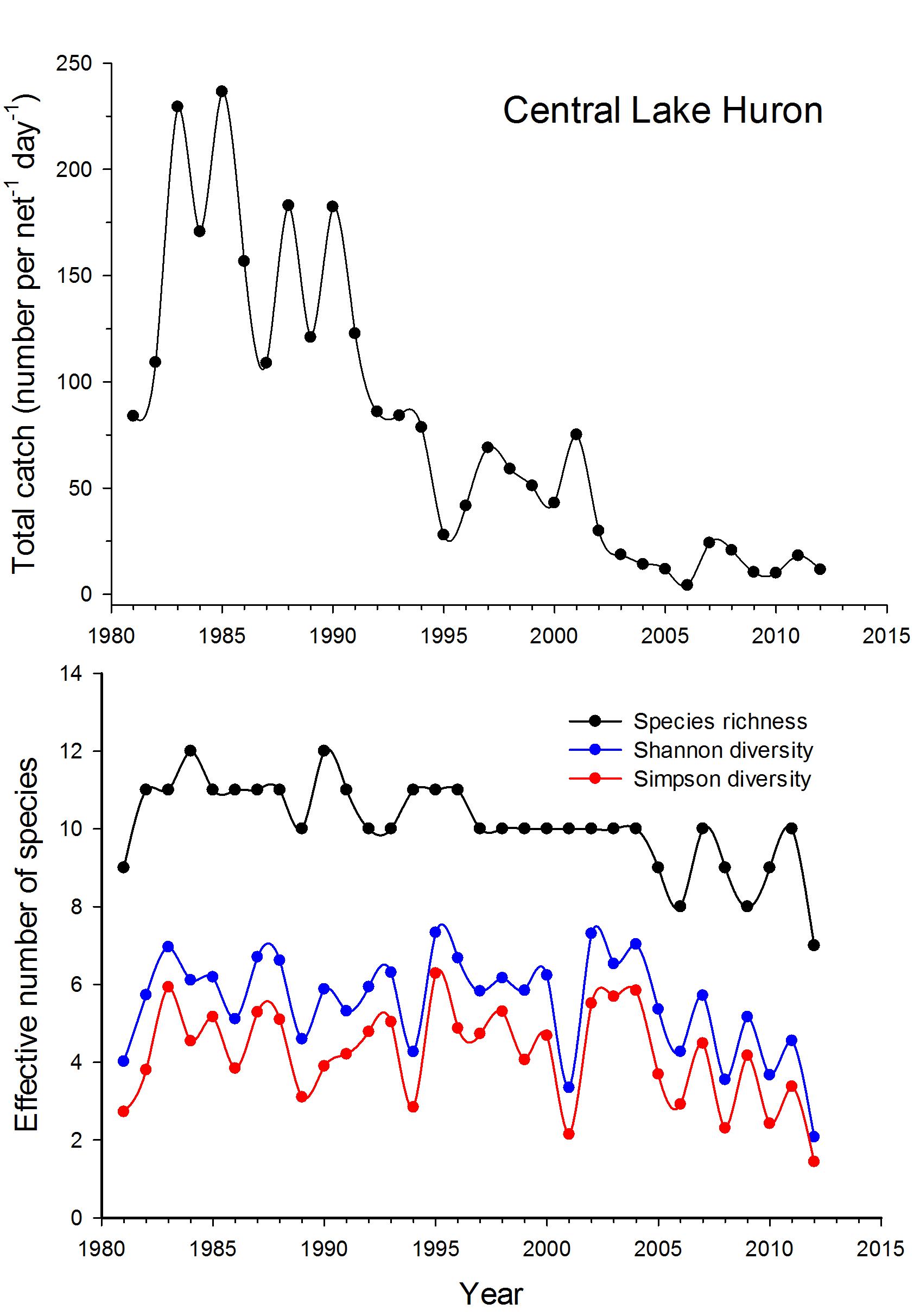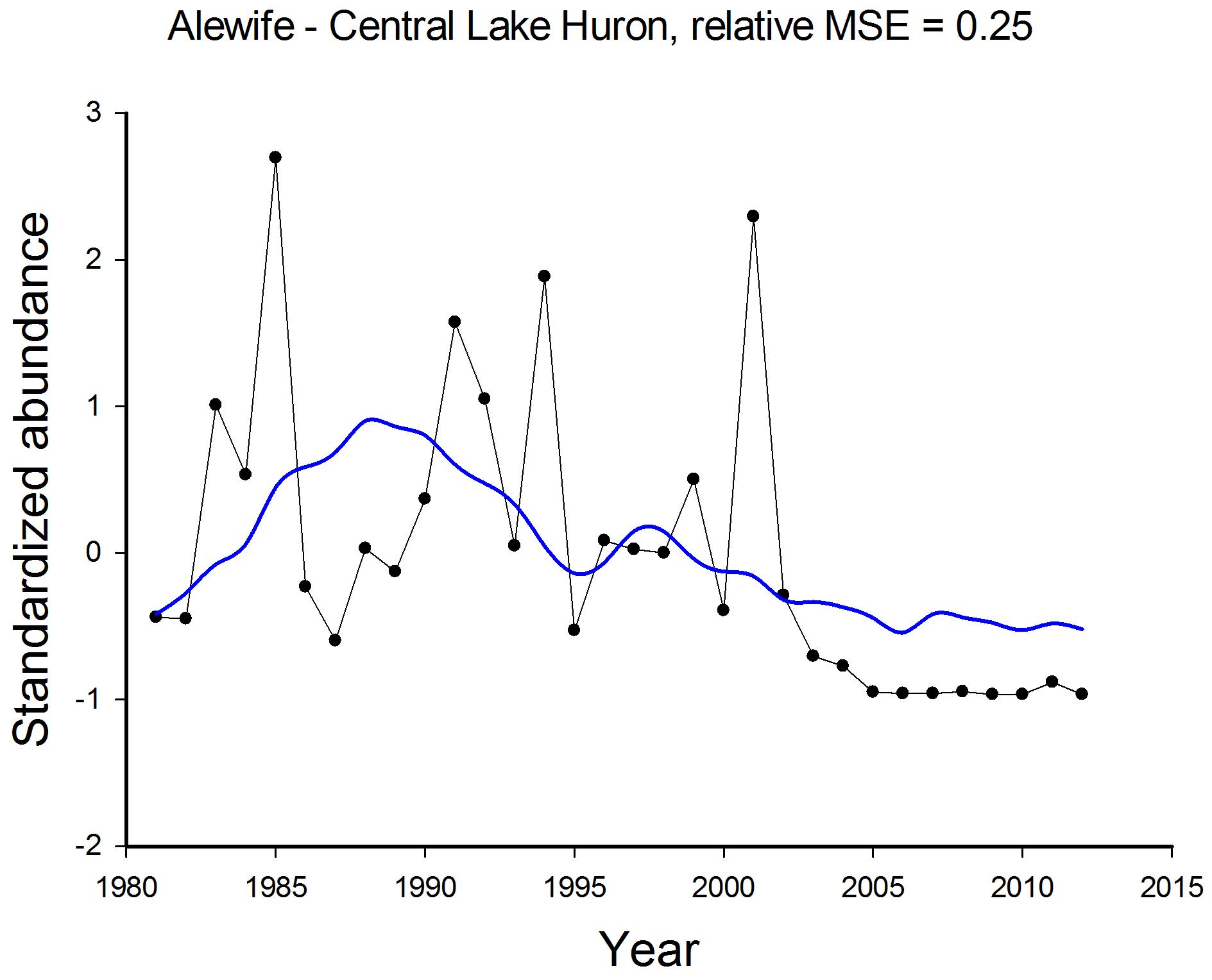Scientists from the Michigan State Universityi have been working with the Ontario Ministry of Natural Resources and Forestry (OMNRF) to study long-term changes to the Lake Huron fish community. The analysis is based on catch data for offshore fish communities at five locations in Lake Huron over the past 30 years from gillnet surveys conducted by OMNRF. Catches were adjusted by sampling effort, as well as by differences in gillnet configurations that have been used over time. Temporal trends in relative abundances for the most common 13 species of fish were examined using a statistical modeling technique called dynamic factor analysis (DFA). DFA estimates common trends among species of fish over time at each location. Measures of species diversity were also calculated over time.
Species diversity did not change substantially over time at any of the sites. In particular, there was no evidence that the number of species found at each of the locations had changed. However, there were substantial declines in the overall abundance of fish, and substantial changes in the relative abundances of different species (Figure 1). This means that although the same number of species was found at each location over time, in later years there were fewer individual fish and relative abundances of individual species changed. Most species declined in abundance, though a few species increased. Based on the results from the DFA, there were two patterns of change that were prevalent across the sites. First, there was a peak abundance that occurred in the early to mid1980s that was followed by a decline that leveled out about 10 years later. The second trend showed a peak in the early 1990s which then either declined throughout the remainder of the time series or else declined and leveled off around 2000. The first trend was associated with widespread decline of Bloater, as well as Longnose Sucker and White Sucker. The second trend was associated with declines in Lake Whitefish and Round Whitefish (and Splake in Georgian Bay) as well as Yellow Perch. In central Lake Huron, the invasive alewife was most strongly associated with the trend that peaked in the early 1990s and then subsequently declined throughout the remainder of the time series (Figure 2).

Figure 1. Temporal trends in gillnet Catch Per Effort and biodiversity measures (species richness and diversity) from Central Lake Huron.
Figure 1. Temporal trends in gillnet Catch Per Effort and biodiversity measures (species richness and diversity) from Central Lake Huron.

Figure 2. Observed (black dots and line) and predicted (blue line) temporal trends in standardized relative abundances of Alewife in Central Lake Huron based on dynamic factor analysis of standardized gillnet Catch Per Effort data.
Figure 2. Observed (black dots and line) and predicted (blue line) temporal trends in standardized relative abundances of Alewife in Central Lake Huron based on dynamic factor analysis of standardized gillnet Catch Per Effort data.
Long-term data on lake temperature, productivity, and commercial catch are currently being accumulated to shed light on these changes. Questions being investigated are whether changes in relative abundances have been primarily driven by inherent changes in the lake ecosystem or by patterns of human consumption of lake resources, or both? The analyses are being extended to include additional locations in Lake Huron that have been sampled by the Michigan Department of Natural Resources to address the generality of the patterns observed in Ontario waters.
________________
iContributed by: Brian A. Maurer1,3, Travis O. Brenden2,3, James R. Bence2,3, and Andrew J. Dennhardt3
1Center for Statistical Training and Consulting
2Quantitative Fisheries Center
3Department of Fisheries and Wildlife
Michigan State University, East Lansing, MI 48824
